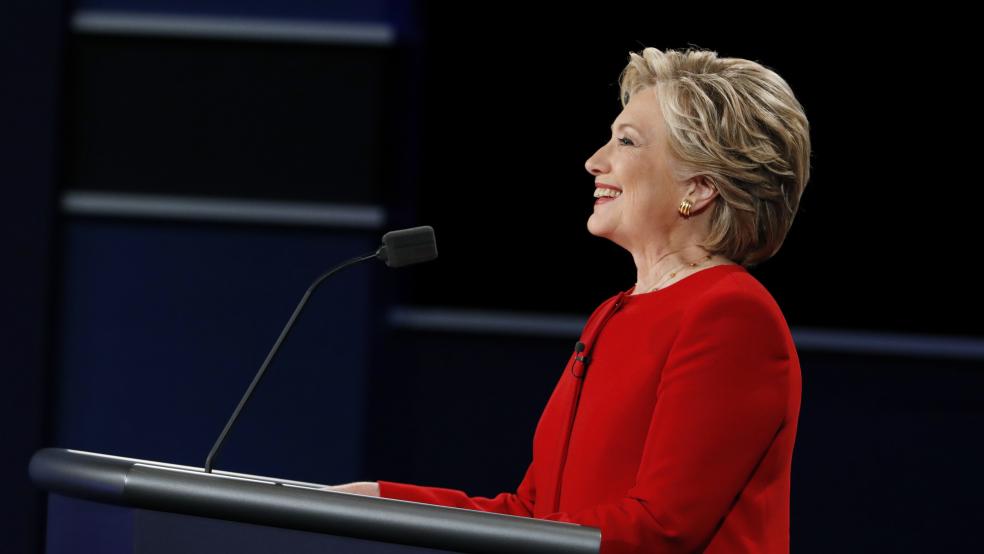With growing signs that she will prevail over Republican nominee Donald Trump in the Nov. 8 election, Democratic presidential nominee Hillary Clinton vowed Friday evening that as chief executive she would “not add a penny” to the gross national debt, which currently stands at an historic $19.7 trillion level.
Speaking at a campaign event in Seattle, the former secretary of state described her tax and spending proposals, including a major tax incsrease on wealthy Americans and high income earners to pay for a plethora of new programs. She compared her plan to Trump’s, which experts say would add trillions of dollars to the long term debt because of massive tax cuts and increased defense spending and border security.
Related: How America’s $19.6 Trillion Debt Would Rise or Fall Under Trump and Clinton
“When people ask me, ‘So how are you going to pay for infrastructure jobs and paid family leave?’ I say, ‘Well, I’m telling you how I’m paying for everything,” she said, as reported by the Washington Examiner. “I am not going to add a penny to the national debt. We’re going to go where the money is. We’re going to make the wealthy pay their fair share, and we’re finally going to close those corporate loopholes.”
While the long-term debt has received relatively scant attention in a presidential campaign that has become consumed by scathing personal attacks, government watchdog groups and policy analysts say that neither candidate can afford to ignore it any longer.
On Friday, the Obama administration confirmed that for the first time since the aftermath of the Great Recession six years ago, the annual budget deficit rose slightly in fiscal 2016 to $587 billion. The increase was due in part to tax breaks for businesses and individuals that Congress extended in December, according to The New York Times, as well as the Treasury’s decision to speed up the payment of government obligations.
Related: Clinton, Trump Clash Over Spending and Taxes but Ignore Nearly $20 Trillion Debt
The financial statement issued jointly by Treasury Secretary Jack Lew and White House budget director Shaun Donovan also showed increases in spending for veterans’ benefits, Medicare and Medicaid and interest on the burgeoning national debt. The $587 billion deficit for the fiscal year that ended Sept. 30 is equal to 3.2 percent of the Gross Domestic Product, compared with the previous year’s deficit of $438 billion or 2.5 percent of the overall economy.
A New Era of Mega Deficits
The non-partisan Congressional Budget Office (CBO), which foreshadowed the rise in the deficit in a report last week, has repeatedly warned that the U.S. is headed for deficits of as much as $1 trillion a year in the coming decade. That dire forecast could be averted if dramatic changes in spending policy along with entitlement reform are implemented.
Analysts have warned that the persistent disconnect between rising spending and languishing revenues cannot be sustained indefinitely, as an aging population has begun to drive up demands for Socials Security and Medicare – among the largest obligations in the federal budget -- while interest on a growing debt will drain more and more government resources.
“The era of declining deficits is officially over, with this year’s $587 billion deficit representing almost a 35 percent increase from last year,” Maya MacGuineas, president of the Committee for a Responsible Federal Budget, said in a statement Friday. “Now that deficits are back on the rise, it’s hard to imagine a more compelling reason for demanding significant reforms to our long-term trajectory.”
Both Clinton and Trump have acknowledged the threat of a return to an era of runaway deficits and debt while promoting nearly diametrically opposite tax and spending policies to spur the economy.
Related: Trump Is Trouncing Clinton When It Comes to Running Up the Debt
Trump, the billionaire real estate developer, has proposed slashing taxes on individuals and businesses by $6.2 trillion over the next ten years, according to a new analysis by the Tax Policy Center, while boosting spending on defense, border security, infrastructure and paid family leave.
Trump’s advisers, using “dynamic scoring” techniques, argue that the tax cuts would practically pay for themselves by encouraging economic growth over the coming decade, and that other savings could be achieved by repealing the Affordable Care Act. However, a recent report by the Committee for a Responsible Federal Budget projected that Trump’s policies would add $5.3 trillion net to the debt in the coming decade.
Clinton, by contrast, would boost taxes by a net $1.4 trillion over the coming decade, with the top one percent of taxpayers bearing the brunt of the overall increase. She would use the new tax revenue to underwrite the cost of her liberal social agenda, including free college tuition, expanded health benefits, paid family leave, a child care tax credit for low-income parents, and highway and bridge construction to assist the middle class and create additional jobs.
Clinton has repeatedly said that she would offset the cost of her ambitious spending policies by “going where the money is” and taxing “the super wealthy.” Her tax plan would target the top 1 percent of taxpayers to pay over 90 percent of the net tax increase.
Related: Fiscal Hawks: Why Is No One Talking About the Deficit?
However, even if Clinton were able to persuade Congress to approve her tax plan, she would still come up short by $200 billion over the coming decade that would be added to the debt, according to the CRFB analysis.
Under Clinton’s approach, the debt would increase from 77 percent of the GDP now to more than 86 percent of the economy by 2026, according to CRFB calculations, while Trump’s would grow the debt to 105 percent of GDP over that same period.





